Solar Telescope
Solar Imaging Telescope
Aditya Darshan - Igniting Young Minds with the Power of the Sun!
.png)
IPR Outreach has set up a solar observing and imaging telescope for outreach activites. This scope has a special combination of optics and interference filters that is tuned to H-alfa emission line of hydrogen, which will enable one to observe (and image) the following phenomenon occuring on the sun's surface that would otherwise remain invisible..
|
IPR Outreach plans to organize sun observation events at IPR campus (as well as outside IPR campus) and also offer short academic projects on observing, imaging, processing and analysis of images of sunspots and prominences of the sun.
|
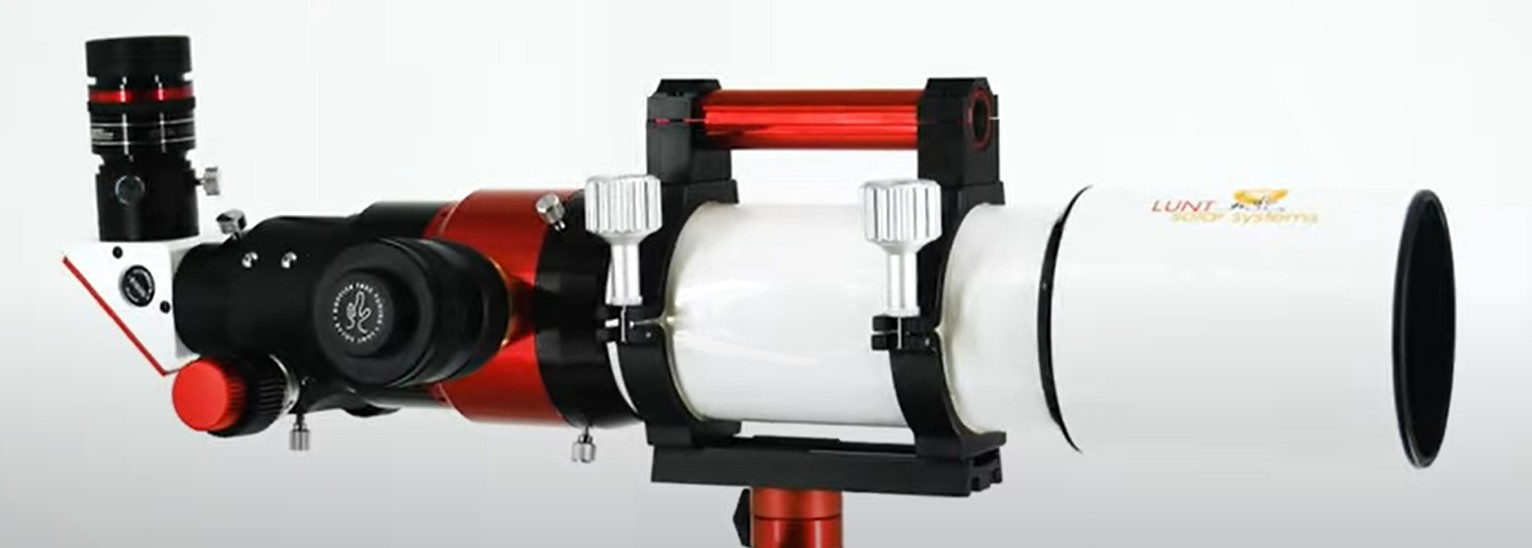
The Solar Imaging Telescope system
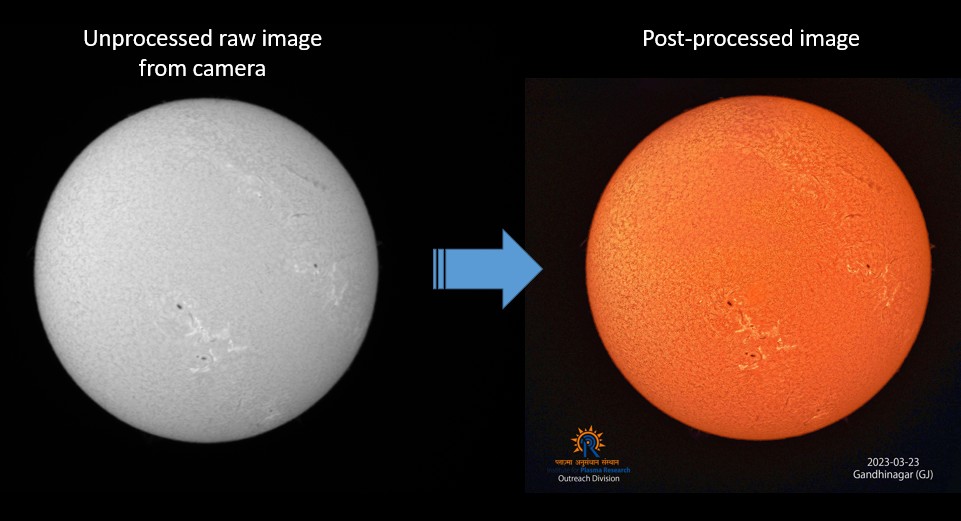
Raw and processed image from the solar telescope
Details of Solar Telescope
| |
Make
| Lunt (USA)
|
Type
| Aperture 80mm, Refractor with doublet lens
|
Filter 1
| Double stack H-alpha with a low bandpass of <0.05 nm for observation at 656.28nm wavelength.
This filter is ideal for observing Prominences, Filaments, Flares and Plages on the surface of the sun.
|
Filter 2
| Calcium-K (Ca-K) filter for observation at 393.4 nm wavelength.
This filter is ideal for revealing some of the magnetic structures (Chromosphere Network) on the surface of the Sun
|
Mount & Tracker
| Skywatcher AZ-EQ6 Pro
|
Cameras
| (1) 20.18 Mega Pixel Color 1" CMOS (USB)
(2) 2.3 Mega Pixel Monochrome 1/1.2" CMOS (USB)
|
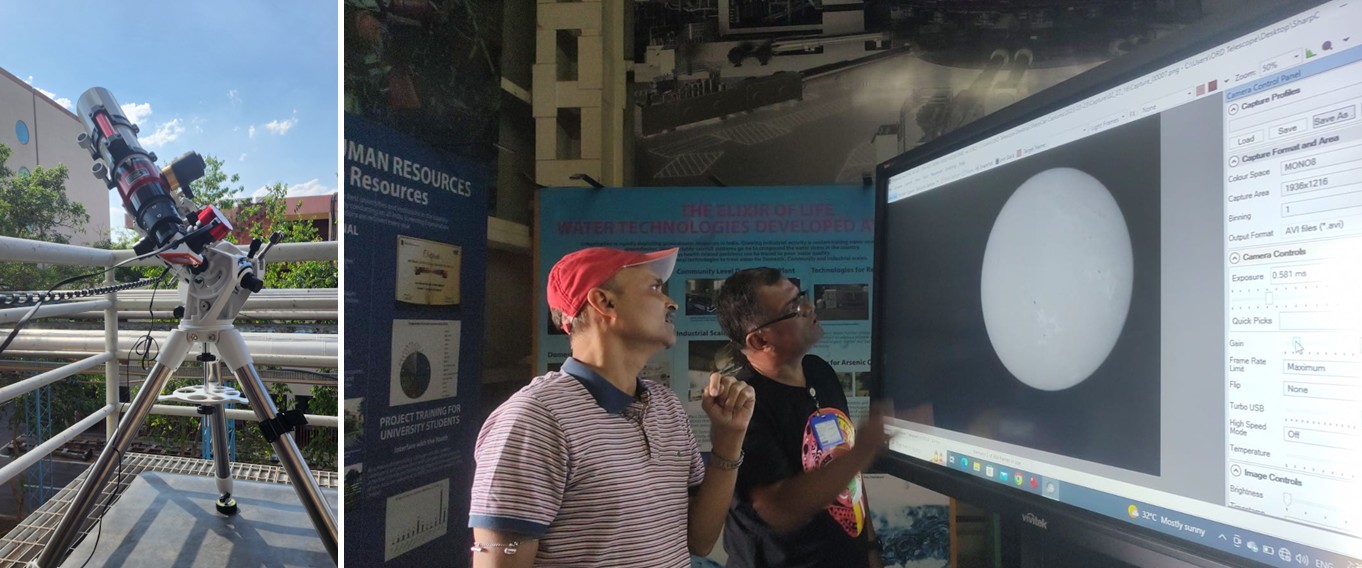 |
(L) The fully assembled telescope on the viewing deck (R) Live display of the image from the telescope
|
 |
IPR students & staff vuewing the sun through the telescope
|
For schools and other institutions interested in conducting solar observation events or students wanting to undertake short projects on sun observation, please contact IPR Outreach Division by email <outreach@ipr.res.in> and/or WhatsApp 78018 34469
|
Our sun is currently heading to its solar maximum (in its 11 year cycle) and is expected to peak in the year 2025. During this period, we will get to see a very active solar surface.
|
What can one expect to see using the solar telescope ?
Sunspots : Sunspots are areas that appear dark on the surface of the Sun. They appear dark because they are cooler than other parts of the Sun's surface. The magnetic field in a sunspot is about 2,500 times stronger than Earth's, much higher than anywhere else on the Sun. Because of the strong magnetic field, the magnetic pressure increases while the surrounding atmospheric pressure decreases.
| 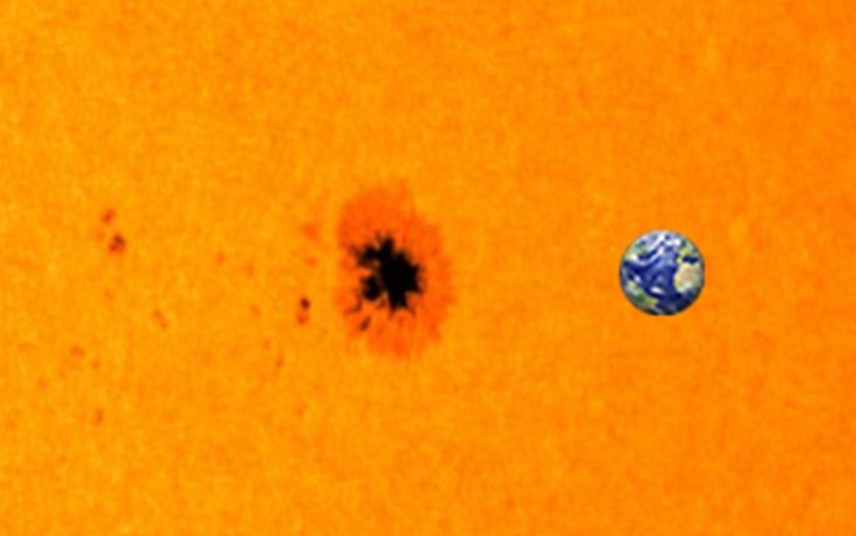 |
Prominences : Immense loops of hot gas suspended over the chromosphere by magnetic fields, they are perhaps the most dramatic features visible with a small telescope and an H-alpha filter.
| 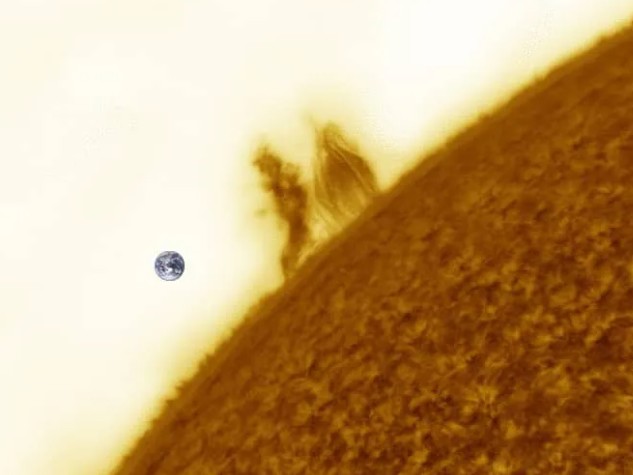 |
Dark Filaments : These are promininces but show up as dark lines when viewed in the backdrop of the solar surface. Both Prominence and filaments are the same structures, yet they appear different due to the angle from which they are viewed.
| 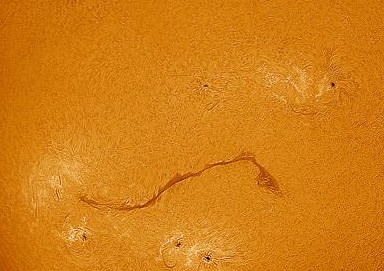 |
Plages : These are bright white cloudy patches associated with sunspots but well above them in the chromosphere. They extend above the photosphere into the chromosphere and can only be seen with the help of Hydrogen-alpha filters.
| 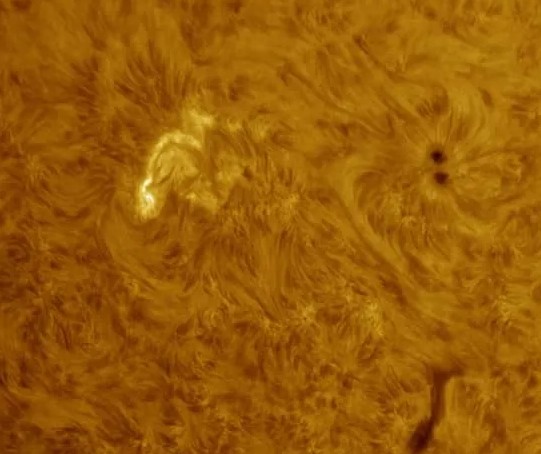 |
Faculae : These are also bright spots/patches on the surface (not to be confused with Plages) produced by concentrations of intense magnetic field lines. Faculae usually occur in the gaps between the granules.
| 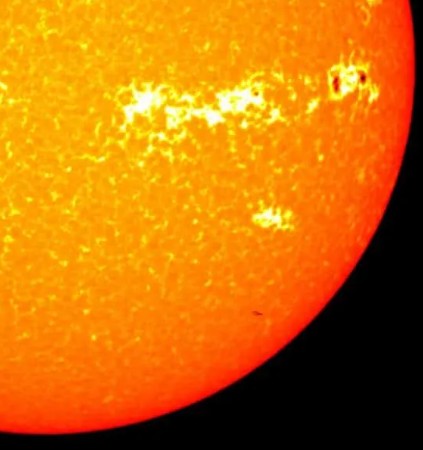 |
Flares : Gigantic and extremely bright ejections of material from the Sun with the energy of millions of hydrogen bombs.Active regions on the solar surface contain magnetic field lines in abundance. These lines overlap, twist, and turn, sometimes breaking to release sudden energy when the region reaches a point of instability. This release of electromagnetic radiation is seen as a solar flare, which increases the local temperature to millions of degrees.
| 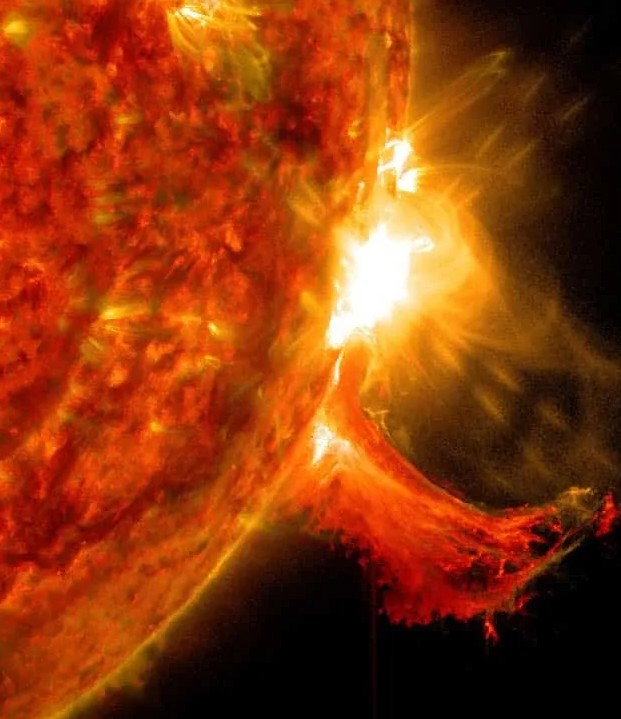 |
Coronal Mass Ejections : Coronal Mass Ejections (CMEs) are ejections of a phenomenal quantity of plasma from the surface of the Sun. These ejections usually happen from prominances. Over several billion tons of solar mass can be ejected into space during a typical CME. Once ejected, CMEs travel at speeds ranging from 250 km/sec to as high as 3000 km/sec and at these speeds, those CMEs directed towards Earth can take anywhere between 15 hours and a few days to reach Earth.
| 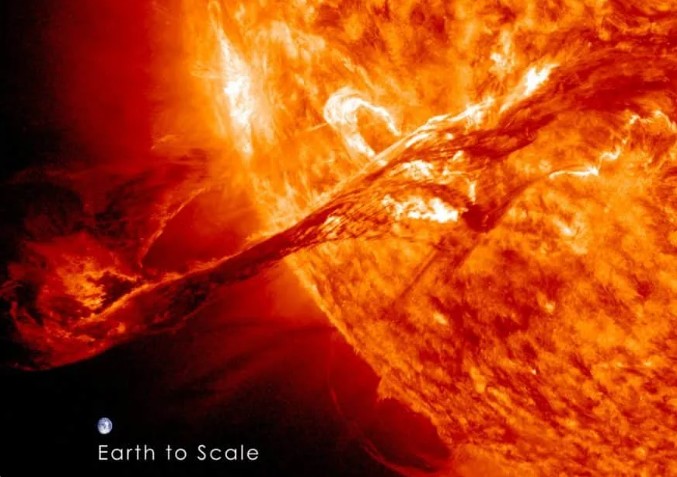 |
Chromospheric Network : These are subtle web-like structures in the chromosphere of the sun. These are most prominently observed with both H-alpha and Calcium-K filters.
| 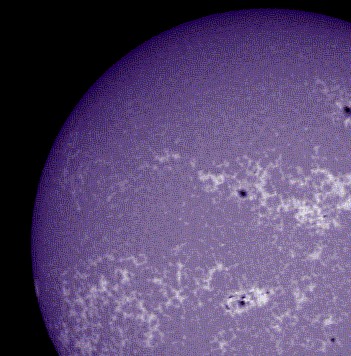 |
Spicules : Small short-lived jets of plasma that move directly upward from the Sun's surface. Spicules have a thread-like appearance, and at any given instance, the solar surface consists of at least 10 million such spicules. These are reponsible for transferring heat throughout the Sun. Spicules have an verage length of ~300km and are short lived (~ 15 mins)
| 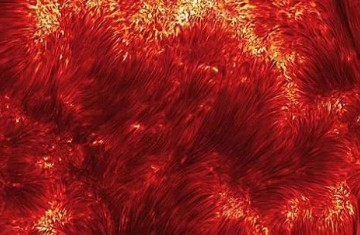 |
Granules and Supergranules : The grain-like structures that make up the sun's surface (except those areas covered by sunspots). Though small telescopes may not show the detailed structures, the shapes of the structure can be clearly seen. These granule are essentially cells of convection currents of plasma in the Sun's convective zone, directly below the photosphere on the sun's photosphere. These are typically 1000km across and constanly in motion.
| 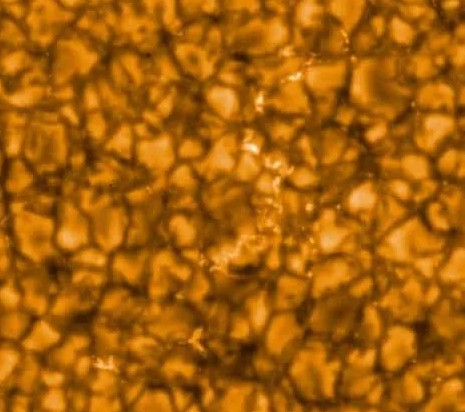 |
All above images have been sourced from various NASA websites
| |
© IPR, 2023
Home Academic Visits | IPR Outreach | Comic Book | Exhibition Hall | Plasma Exhibition | People | Resource Materials | NSD2026 | Social Outreach | Solar Telescope | Training Program | TokoToy | Vigyan Samagam | 2022 Events | 2023 Events | 2024 Events | 2025 Events | Upcoming Events | FAQ FAQ | Contact Contact | Ask A Question Ask A Question | Talk 2 Us Interact with a Plasma Scientist |
